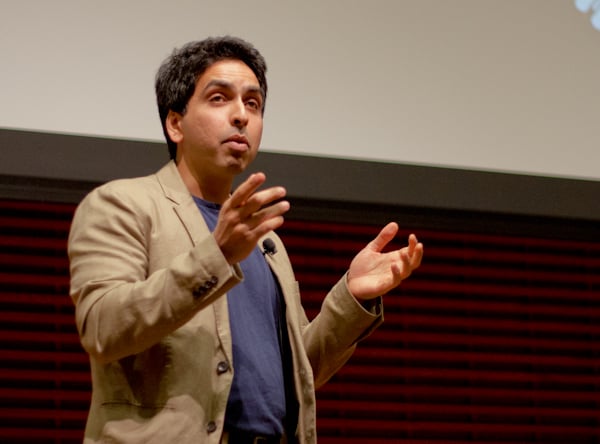“Nowadays, there is so much emphasis on student-to-teacher ratio,” said Salman Khan, founder of the online educational site The Khan Academy on Thursday evening at Cemex Auditorium in the Graduate School of Business. “We at The Khan Academy do not believe in this multiple — we believe in optimizing student-to-valuable-time-with-teacher ratio, or even more importantly, student-to-valuable-time-with-other-human-beings ratio. A one-size-fits-all lecture is not the way to go about education.”
Invited to Stanford as part of the Expert Speaker Series by the Mastery in Communication Initiative, Khan spoke about how his website, with more than 3,000 lectures and almost four million unique visitors a month, has grown to become a world-renowned leader in the field of online education.

Khan started his talk with a history of The Khan Academy.
“I was a hedge-fund analyst in Boston when my younger cousin, Nadia, came to visit, and I noticed that this brilliant child, who could solve brain-teasers way harder than what would be expected by a twelve-year old, still had gaps in the most fundamental level math,” Khan said.
According to Khan, the problem with the current educational system is that the time spent teaching one subject is fixed, and only the student’s level of mastery is variable. What his website is trying to achieve is to make the amount of time spent learning variable in order for a student to attain a certain level of mastery.
“We cannot build a house on an 80 percent sound foundation, and then blame the contractor of the fourth floor when the building collapses,” Khan said. “It would be like expecting a child who can barely break or turn left on a bicycle to become a master unicyclist.”
After the revelation he had while tutoring his cousin, a friend pitched Khan the idea of uploading some of the videos he had filmed of their tutoring sessions to YouTube.
“I had to go home and deal with the idea that I did not come up with that idea myself,” Khan said, adding “this is something very hard for an MBA.”
Using YouTube as a medium to convey knowledge was something that had not crossed his mind.
“YouTube is for cats playing the piano!” Khan joked.
The videos took off, and the children he had previously tutored told him they preferred seeing him on YouTube than in person.
“They can work at their own pace, repeat, rewind, fast-forward,” Khan explained. “There is no distraction, and more importantly, there is no shame. They do not feel like they are wasting my time.”
After quitting his job and getting several generous donations from, among others, the Gates Foundation and Google, The Khan Academy is now used in more than 700 different schools and has delivered more than 121 million lectures to date.
“It is amazing what this has become,” Khan said. “We receive testimonies from children with learning disabilities, dyslexia, ADHD and autism that are — all for the first time — able to understand algebra or physics or economics.”
Khan and his team are currently building a platform that would allow anyone to tutor and teach others, he said. The short-term goal is to help the average student become proficient in subjects with which he or she has trouble.
“There is an abundance of opportunity for developing The Khan Academy,” Khan said. “In the long run, we envision being able to offer kids in rural Africa access to an education better than they could ever dream of, and enabling children with chronic diseases, student athletes, actors or prisoners to receive a free equivalent to in-person tutoring.”
“One couldn’t help but be swept away by the content of his talk,” said student attendee Aaron Sekhri ‘15. “His sincerity and good nature were obvious, and it was perhaps the best talk I’ve been to this year.”